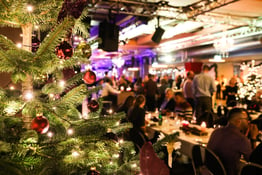If a picture is worth a thousand words, the math on videos gets wild in a hurry. At a standard 23.98 frames per second, a one-minute video is worth 1.4 million words — think "War and Peace," times three. As a still photographer and videographer, I’m always looking for ways to measure the value of photos and video, whether people want to go by views, engagements — or in your case perhaps, new and returning customers.
No matter how you measure it, a thoughtful video is a powerful thing. As it happens, too: Food brings out the best in video. More than a still photograph of a dish or a drink, video allows us to tell a story, to convey emotion, and to open the door to unlimited creativity. “Videos are important because they provide a visually beautiful narrative to what the restaurant is all about,” food photographer and content creator Ben Hon tells me. “Seeing and hearing the food being cooked and plated has a much more stimulating effect than a still photo.” Kyung il Lee, the owner of the New York seafood restaurant Sagaponack, has been dedicating a lot of time recently to creating his own content. He also tells me that video has become king online: “We can make it entertaining, digestible, and informative, in a way we can’t do with other forms of content.”
The marriage of food and video isn’t just an open secret among restaurant operators; it has helped to transform the internet. If you’re on TikTok, you already know what a huge influence food accounts are on that platform. And if you use Instagram, you’ve surely noticed the gradual video takeover on a site that used to be all about sharing photos. “Video is driving an immense amount of growth online for all the major platforms right now,” Adam Mosseri, the head of Instagram, said on Twitter in 2021. And then, in 2022: “More and more of Instagram is going to become video.” Can’t say he didn’t warn us.
After close to a decade churning out fast-paced content for local news, I started creating editorial video for the Michelin Guide in 2017. I relished the opportunity to slow down, to tell stories through beautiful visuals, and to create what felt like an antidote to the context-free sped-up recipe videos that were trendy at the time. Through my shots and edits, I created a recognizable brand style in my voice, and was immediately rewarded with multiple Telly Awards and an Emmy nomination. The way I capture video has shifted over the years, but I’ve remained proud of the impact my work creates. Telling stories in a thoughtful way resonates with people, whether that’s across an hour-long documentary or a spry 15 seconds.
So how do you, a restaurant pro and video amateur, get your visual work up to that level? Do you focus on quantity, or quality? Do you hire a professional, or do it yourself? Video as a medium is endlessly customizable, and thus, a medium you have to tailor to your needs and strengths. What works for your business may be very different than what works for another.
The best way to start is to experiment on your own first using tools and resources you already have at hand. Phone camera technology has gotten stellar, and will give you an impressive image right from the start, on low-to-no budget. Once you get comfortable shooting with your phone, you can take a few steps to ensure your restaurant marketing will stand out amid a very crowded field. Here’s where to start.
First, determine your platform
Ask yourself, where will this video live? The platform you upload to will determine how you shoot. If you are sharing content on YouTube or Vimeo, then you’ll want to shoot horizontal (16x9 format, indicating the ratio of the video’s width to its height). Those platforms are generally more friendly to content longer than a minute or two.
If you plan to share content on Instagram or TikTok, you’ll want to shoot vertically and keep the whole thing under 60 seconds. Further, if you’re using Instagram, you’ll want to think about where your video will go; Stories, your regular feed, and Reels all digest video differently.
Whatever platform you choose for your overall social media strategy, your results are going to develop over some amount of trial and error. As you get started, I recommend making a private test handle and uploading a few samples to see what works and what doesn’t.
Next, decide what you want the video to accomplish
Once you know where your video will be, make a brief plan for what your video will be. What is the goal? Are you showing viewers how to make something, or do you want to entice them to come in for dinner? Are you highlighting an employee, or just showing off your space? We all tend to overcomplicate things so my advice here is to start simple. Take a step back and assume your viewers or followers know nothing about your restaurant. Give them the basics. Instead of highlighting a full menu, show off one dish. Say what the dish is, what it tastes like, where and when you can get it. What are the simple visuals that will tell that story? Make a shot list before you dive in.
Once you do your groundwork, and start to experiment with your shots and angles, you’ll find inspiration striking at different moments. Follow that instinct. At worst, you can always delete your file later. At best, you may have material to connect with your audience. “If I come up with an idea of a concept, I’d write it down,” Lee says. “Sometimes, I’ll come across something that looks interesting, and will whip out my phone to capture the moment.”
Finally, it might sound silly, but think about how you want to make people feel. I believe emotion is a big driver of successful video. Do you want people to feel touched by something that happened? Excited about coming in? A sense of calm on a cold snowy day? Deciding this ahead of time will help determine the vibe when you shoot.
How to set up great lighting for food videos
Once you know what you need to capture, then you can get into the how. First and foremost is lighting. Bad lighting can ruin even the prettiest dishes. When I walk into a space to shoot dishes, the first thing I do is turn off overhead lights. Fluorescent light is not flattering, and yellow tungsten light can often create weird, ugly reflections that you have no control of.
Take advantage of natural lighting when shooting a dish. Find a window, and move your phone or camera around until you find the most flattering angle. My favorite tool in my kit is a large piece of white cardboard. Use it to bounce sunlight back onto the dish, to fill in harsh shadows and brighten the overall feel.
If you don’t have natural light at your disposal you can get reasonably priced artificial lights such as this portable Lume Cube. Now, instead of shining the light directly onto your subject, bounce the light into the white cardboard, or into a wall right next to your dish. Bounced light (also known as “passive fill”) is almost always the most flattering.
If you’re going to film people’s faces, first pause. Note any weird shadows or funky colors on their skin. Move your subject around until what you see in person looks good. Then pick up your camera.
How to capture audio for food videos
If you are recording a voice for your videos, sound quality is vital. You can have Oscar-worthy visuals, but shoddy audio will tank them in a blink. Your audience is more likely to put up with mediocre video with excellent audio than a beautiful video with crappy sound. Really poor sound — that is, sound that’s overmodulated (distorted from being recorded too loud) or sound that’s cluttered with background noises — is horribleto listen to. Unless you’re going to cover your video with voiceover and music, dedicate just as much attention to your sound as you do your visuals.
You don’t need a fancy microphone set up to do this; an iPhone or wired headphones are just fine, so long as you adhere to a few basic guidelines.
Keep background noise to a minimum. Turn off AC and oven vents. Make sure there are no blenders running, no one is on the phone behind you, doors aren’t slamming. If a siren passes on the street, just do another take.
Speak close to your phone if you’re recording sound directly on it. Too far away and you’ll sound like you’re in a tunnel.
Test your mic before recording with an external microphone. Listen to your levels to make sure the recording volume is neither distorted nor overly loud.
Some dos and don’ts of shooting good food video
Once the basics are set up, and you know what you’re filming and where, the rest is just trial and error. Let me offer you a few guidelines that will cut down on your errors.
Keep your recording time short. Don’t press record and leave the camera rolling for nine straight minutes. Pick your shot, record the action, stop. You’ll conserve storage and time in the edit.
Stay steady. Any shot that moves too fast or too shakily turns people off. When in doubt, slow down. Prop your arm or your phone on an even, steady surface. Or, if you decide you need a tripod, this JOBY Gorillapod should work fine.
Show us what you’re talking about. If your bartender is talking about his tasty Boulevardier cocktail, show the Boulevardier cocktail being made, not the sidewalk outside.
Keep. It. Simple. Everyone is overloaded on information. Keep your video simple, to the point, and brief.
Don’t buy expensive equipment. At least, not at first. Focus on mastering skills and techniques with a simple phone setup before you over-invest in gadgets. If you later decide to upgrade, great, you’ll have a far greater sense of what you actually need.
When you should hire a professional for your food video
Hiring out for video work can be costly — for good reason. The single camera alone can cost a shooter around $10,000, and that's before they invest in lenses, audio equipment, and lighting. Then you have to consider post-production costs such as editing software, music licensing, and hard drive storage, as well as the physical labor involved with filming. (Yes, I need a good chiropractor.)
On occasion, you may decide you want to get a pro to handle the shoot, especially when it’s a high-stakes event. Maybe you need a formal interview, a celebrity ambassador is coming in, or you want someone to trick out the visuals in a short vid. You might have an important event or opening night that you need to ensure is fully captured, or you might have a chef or manager trying to tell a special story. You can also hire out a job simply because you’ve tried your hand and don’t feel you’re getting the quality or the style you’re going for.
A professional might also help you think bigger than quick hits for TikTok. I love when a business has the budget to bring me in and do a 4- or 5-minute mini documentary on their team, or to capture an opening night. Professional videographers value quality over quantity, so we are not the people to hire if you need a large volume of content in a short amount of time. “It's extremely important for the restaurant to hire a good videographer who can shoot and edit in a style that matches the mood and feel of the restaurant,” Ben Hon says. “Perhaps create a mood board and shot list together so that everyone is on the same page.”
The possibilities for what you can do with a professional — socials, mini-docs, longer dives into your restaurant’s story — are vast. Go with an approach that fits your brand and budget, and then stick with it. In this business, consistency is key to building an audience and letting them know what to expect. I recognize that adding one more project to the already massive task of running a restaurant can be a lot, but I also agree with Kyung il Lee’s approach. “Having fun with it is the most important to me,” he says. “If you enjoy it, you’ll create better and more content.”
Kathryn Sheldon is an Emmy Award-winning photographer and director of photography based in Brooklyn, New York. You can find her work at kathrynsheldon.com.
[Photo by Gustavo Fring, via Pexels]





